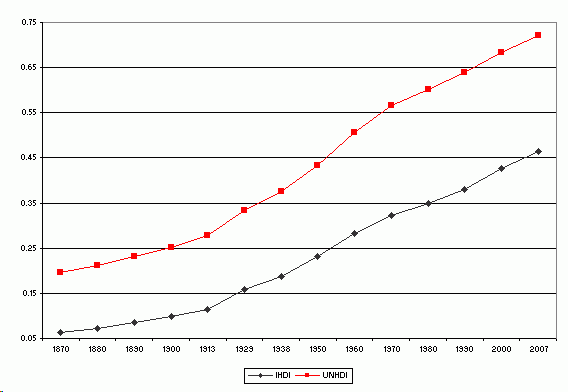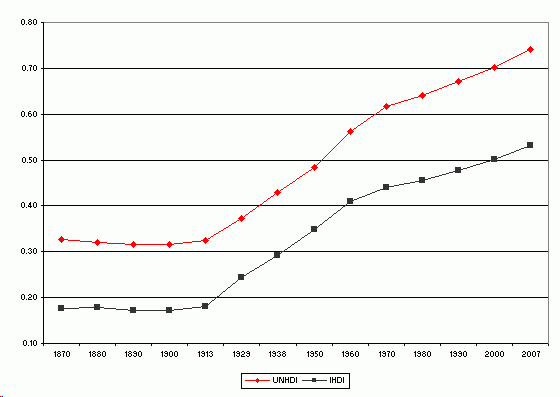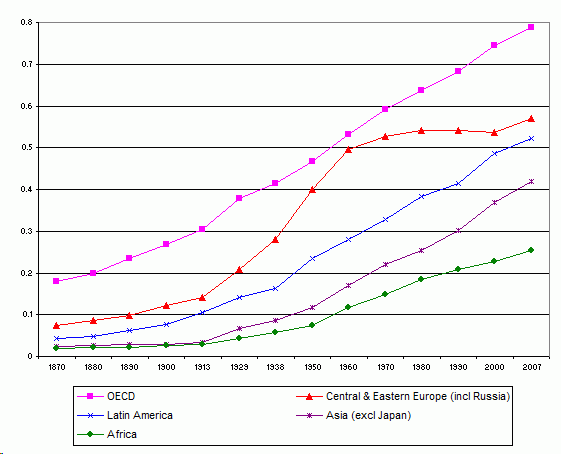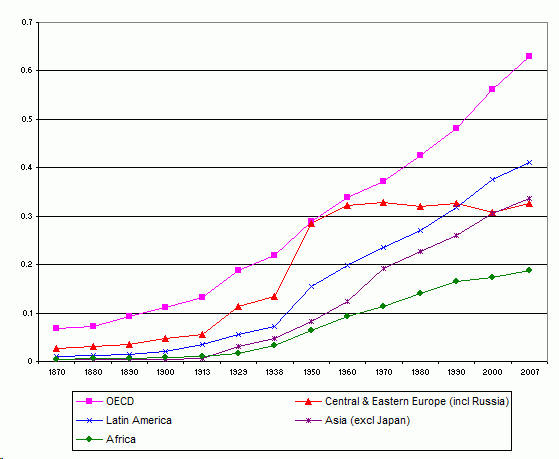In the ongoing debate on the Millennium Development Goals the appropriate measurement of different social indicators appears to be crucial. Central to these are the indices of human development provided by the UNDP Human Development Reports (HDR) since 1990. Yet somehow the pessimistic view of many developing countries offered by HDR seems at odds with their benign figures of human development relative to the developed world, in particular when compared to their relative economic record.
An “improved” index of human development
In an attempt to disentangle such a paradox a new, I have worked on an “improved” human development index. This new index follows Kakwani (1993), in that social dimensions are obtained using a “convex achievement function”, that is, as a social indicator (i.e., life expectancy) reaches higher levels, its increases represent higher achievements than had the same increase taken place at a lower level. This is in contrast with the conventional UNDP index (UNHDI) in which equal changes represent the same achievement, regardless the starting level.
The new index also combines human development dimensions through a geometric average rather than an average one. This has the advantage of reducing the substitutability of such diverse human development measures as longevity, knowledge, and the log of per capita income.
Comparing the new index and the old
Although both indices cast roughly the same trends for the world as a whole, major discrepancies exist in their depiction of human development. A significant difference is observed in their initial levels and a gap between them widens over time, with the “improved” human development index (IHDI) lagging behind. In terms of the conventional Human Development Report categories –“low” (<0.5), “medium” (0.5), and “high” (0.8) levels – the average level of human development in the world belongs to the “medium” level since 1960 and is approaching the “high” level, according to the conventional UNHDI. Yet according to the new IHDI, today’s average human development still remains in the “low” category.
Figure 1. Human development in the world: IHDI and UNHDI, 1870-2007
When compared to the UNDP index, the new IHDI provides systematically lower levels of human development for the developing countries and highlights the gap between developed (OECD1) and developing countries (“the Rest”) justifying the HDR concern for international differences.
Figure 2. Human development in the ‘rest’ relative to OECD according to UNHDI and IHDI, 1870-2007
Human development trends according to the new index
A substantial improvement in human development has taken place in the world since 1870 –with special intensity between 1913 and 1960 – largely conditioned by regional behaviour.
A regional breakdown (Figure 3) shows Central and Eastern European impressive catching-up to the (pre-1995) OECD between the 1920s and 1960 – driven by Soviet Russia’s gains in human development – followed by stagnation and, then, divergence. Latin America caught up to the OECD until the 1970s, and more intensively during the early twenty-first century. Asia, starting from lower levels – similar to those of Africa up to the early 1920s – improved significantly until 1970 and, again, at the turn of the century. In Africa, a sustained improvement took place between the 1920s and the 1970s –especially in the 1930s and 1950s – but improvements in human development have slowed down since 1980. As a result of these regional trends, Asia’s catching up and Eastern Europe’s falling behind has led these two regions to converge with Latin America, while Africa and the OECD diverge at low and high levels of human development.
Figure 3. Human development across world regions: IHDI, 1870-2007
The contribution of life expectancy to human development
Gains in the IHDI are driven by achievements in its social dimensions. Life expectancy (Figure 4) is the main contributor to improving world human development over the long run, and specifically between 1880 and 1990. This fact is associated with the diffusion of new methods of preventing the disease transmission, including low cost improvements in public health and knowledge dissemination through schooling and to the introduction of new vaccines (since the 1890s) and drugs to cure infectious diseases (sulfa drugs since the late 1930s and, since the 1950s, antibiotics).
Figure 4. Life expectancy indices across world regions, 1870-2007
The gap between OECD and the rest
The absolute gap between OECD and the rest – that is, the difference in human development values – has deepened over time, especially until 1929. A closer look at different developing regions reveals that most of the OECD absolute gap with Latin America and Asia (excluding Japan) originated in the late nineteenth and the first half of the twentieth century, becoming relatively stable since the 1950s. However, the absolute gap between OECD and Africa increased steadily throughout the twentieth century, accelerating since 1980. Central and Eastern Europe represents an outlier, with its gap to OECD closing between 1929 and 1960 to widen dramatically thereafter, converging to the OECD-Latin America gap.
Yet the relative gap – that is, the ratio of human development values – between the OECD and the rest fell from 1900 to 1960 and stabilised for the last half a century, in contrast with the increasing gap in per capita income. The relative gap between OECD and each of the developing regions shrank over time, but while by mid-twentieth century the main reduction had already taken place in Latin America and in Asia (excluding Japan), the relative gap between OECD and Africa declined, and more gradually, over 1913-1980. The OECD gap with Eastern Europe (including Russia) provides the exception – after falling to a minimum by 1960, it increased to recover its pre-World War II size.
What share in the reduction of the relative gap in human development between the OECD and the rest is attributable to each of its dimensions? During the phase of deeper decline (1913-60) life expectancy accounted for most of the changes during 1913-29 and 1938-50, while education was the main factor responsible during the Depression years and in the 1950s. Since 1970, the closing of the gap slowed down, with education as the leading contributor.
To sum up, the human development gap between OECD and the rest has not closed as the catching up in life expectancy has stopped – largely due to its stagnation in Eastern Europe, especially in Russia, since 1960 (and its decline in the 1990s) and the remarkable slowdown in Africa since 1990, as a result of HIV/AIDS – while the catching up in education has weakened.
How do today’s developing countries compare to advanced nations in the past?
By 2007, the level of human development in the rest was similar to that of the OECD in 1938. For major world regions in 2007, the average human development level in Central and Eastern Europe (including Russia), Latin America, Asia (excluding Japan), and Africa matched those of the OECD in 1965, 1960, 1938, and the 1890s, respectively.
In general, developing countries perform better in human development than in income per head terms as the provision of health and education has increased more than proportionally to income per head. Thus, in 2007, real per capita GDP for the rest was similar to that of OECD by 1925. Furthermore, in 2007, Latin American, Asian, and African real per capita GDP was similar to that of OECD in the early 1950s, 1920, and mid-nineteenth century, respectively.
References
Kakwani N (1993), ‘Performance in Living Standards. An International Comparison’, Journal of Development Economics, 41:307-336.
Prados de la Escosura, L (2010), ‘Improving Human Development: A Long-run View’, CEPR Discussion Paper 7982.
1 OECD here refers to its pre-1995 members: Australia, Austria, Belgium, Canada, Denmark, Finland, France, Germany, Greece, Iceland – only since 1990-, Ireland, Italy, Japan, Netherlands, New Zealand, Norway, Portugal, Spain, Sweden, Switzerland, the UK and the US. No estimates have been obtained for Luxemburg. Turkey, although an OECD member, has been included in Asia in order to make a more homogeneous group in terms of development. New members since 1995: Czech Republic, Hungary, and Slovakia, are not included in OECD and assigned to Eastern Europe; South Korea, in Asia; and Mexico, in Latin America.







